gearbox Peugeot Expert VU 2016 Owner's Manual
[x] Cancel search | Manufacturer: PEUGEOT, Model Year: 2016, Model line: Expert VU, Model: Peugeot Expert VU 2016Pages: 599, PDF Size: 13.14 MB
Page 5 of 599

.
.
Expert_en_Chap00a_sommaire_ed01-2016
Driving recommendations 196
Starting-switching off the engine, manual key, remote control
1
99
Starting and switching off the engine, "Keyless Entry and Starting"
2
02
Parking brake
2
05
Hill start assist
2
06
5-speed manual gearbox
2
07
6-speed manual gearbox
2
07
ge
ar shift indicator
2
08
Automatic gearbox
20
9
Electronic gearbox
2
14
Stop & Start
2
18
Head-up display
2
22
Memorising speeds
2
24
Speed limit recognition
2
25
Speed limiter
2
29
Cruise control
2
32
Dynamic cruise control
2
36
Collision Risk Alert and Active Safety Brake
2
43
Lane departure warning system
2
48
Fatigue detection system
2
50
Blind spot monitoring system
2
52
Parking sensors
2
55
Reversing camera, interior mirror
2
58
180° rear vision
2
59
Under-inflation detection
2
62Fuel tank
2 65
Diesel misfuel prevention 26
6
Snow chains
2
68
to
wing a trailer
2
69
Energy economy mode
2
70
Accessories
271
Roof bars / Roof rack
2
73
Changing a wiper blade
2
74
Bonnet
276
Diesel engine
2
77
Checking levels
2
78
Checks
281
AdBlue
® and SCR system
(BlueHDi Diesel) 2 83
Warning triangle (stowing)
2
87
to
ol box
2
87
te
mporary puncture repair kit
2
90
Changing a wheel
2
96
Changing a bulb
3
03
Changing a fuse
3
16
12 V battery
3
21
to
wing
325
Running out of fuel (Diesel)
3
27Dimensions
328
Engines
332
Weights
332
Identification markings
3
37
Driving
Practical information
In the event of a breakdownte chnical data
Emergency or assistance 338
PEu gEo t Connect Nav 3 41
PE
u
g
Eo
t Connect Radio
4
29
Bluetooth
® audio system 4 83
Audio equipment and telematics
Alphabetical index
Contents
Page 8 of 599
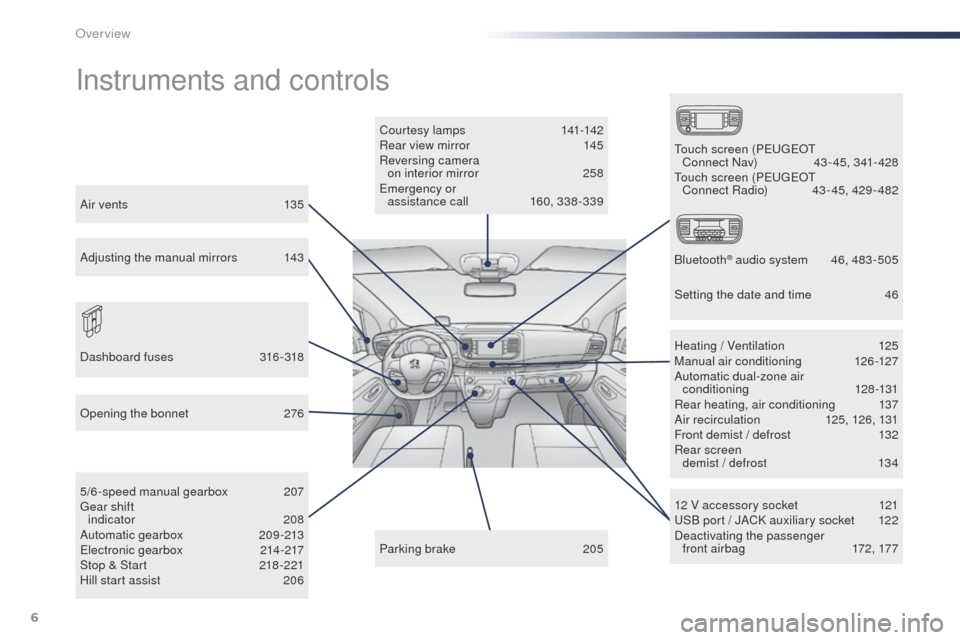
6
Expert_en_Chap00b_vue-ensemble_ed01-2016
Instruments and controls
Courtesy lamps 141-142
Rear view mirror 1 45
Reversing camera on interior mirror
2
58
Emergency or assistance call
1
60, 338 -339
12 V accessory socket
1
21
uS
B port / JACK auxiliary socket
1
22
Deactivating the passenger front airbag
1
72, 177
5/6-speed manual gearbox
2
07
ge
ar shift
indicator
2
08
Automatic gearbox
20
9-213
Electronic gearbox
2
14-217
Stop & Start
2
18 -221
Hill start assist
2
06 Heating / Ventilation
1
25
Manual air conditioning
1
26-127
Automatic dual-zone air conditioning
128-131
Rear heating, air conditioning
1
37
Air recirculation
1
25, 126, 131
Front demist / defrost
1
32
Rear screen demist / defrost
1
34
Parking brake
2
05
op
ening the bonnet
2
76
Dashboard fuses
3
16-318
to
uch screen (PE
u
g
Eo
t
Connect Nav)
4
3 - 45, 341- 428
to
uch screen (PE
u
g
Eo
t
Connect Radio)
4
3 - 45, 429 - 482
Bluetooth
® audio system 4 6, 483 -505
Air vents
1
35
Adjusting the manual mirrors 1
43
Setting the date and time
4
6
over view
Page 14 of 599
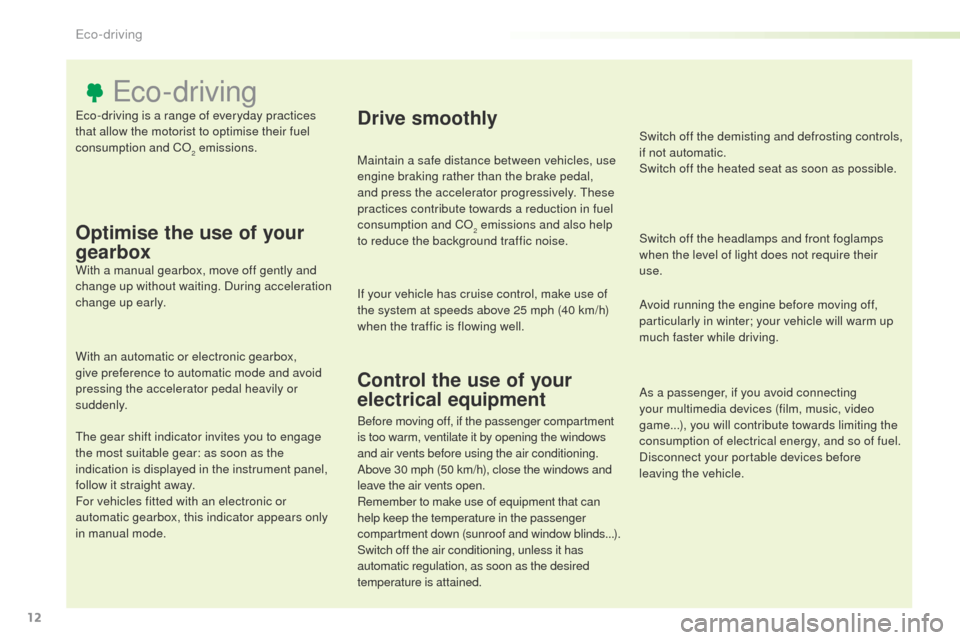
12
Expert_en_Chap00c_eco-conduite_ed01-2016
Eco-driving is a range of everyday practices
that allow the motorist to optimise their fuel
consumption and Co
2 emissions.
Eco-driving
Optimise the use of your
gearbox
With a manual gearbox, move off gently and
change up without waiting. During acceleration
change up early.
With an automatic or electronic gearbox,
give preference to automatic mode and avoid
pressing the accelerator pedal heavily or
suddenly.
th
e gear shift indicator invites you to engage
the most suitable gear: as soon as the
indication is displayed in the instrument panel,
follow it straight away.
For vehicles fitted with an electronic or
automatic gearbox, this indicator appears only
in manual mode.
Drive smoothly
Maintain a safe distance between vehicles, use
engine braking rather than the brake pedal,
and press the accelerator progressively.
t
h
ese
practices contribute towards a reduction in fuel
consumption and C
o
2 emissions and also help
to reduce the background traffic noise.
If your vehicle has cruise control, make use of
the system at speeds above 25 mph (40 km/h)
when the traffic is flowing well.
Control the use of your
electrical equipment
Switch off the demisting and defrosting controls,
if not automatic.
Switch off the heated seat as soon as possible.
Switch off the headlamps and front foglamps
when the level of light does not require their
use.
Avoid running the engine before moving off,
particularly in winter; your vehicle will warm up
much faster while driving.
As a passenger, if you avoid connecting
your multimedia devices (film, music, video
game...), you will contribute towards limiting the
consumption of electrical energy, and so of fuel.
Disconnect your portable devices before
leaving the vehicle.
Before moving off, if the passenger compartment
is too warm, ventilate it by opening the windows
and air vents before using the air conditioning.
Above 30 mph (50 km/h), close the windows and
leave the air vents open.
Remember to make use of equipment that can
help keep the temperature in the passenger
compartment down (sunroof and window blinds...).
Switch off the air conditioning, unless it has
automatic regulation, as soon as the desired
temperature is attained.
Eco-driving
Page 16 of 599

14
LCD instrument panel
1. Analogue speedometer (mph or km/h).
2. Engine coolant temperature gauge.
3.
C
ruise control or speed limiter settings.
4.
D
igital speedometer (mph or km/h).
5.
g
e
ar shift indicator.
g
e
ar with an automatic or electronic
gearbox. A. M
ain lighting dimmer.
B. S ervice indicator reset.
I
f fitted to your vehicle, trip recorder reset.
D
ate and time adjustment.
I
nstantaneous information on:
-
servicing,
-
r
emaining driving range with the
emissions control fluid (AdBlue
®).
6.
F
uel gauge.
7.
E
ngine oil level indicator.
8.
S
ervice indicator, then total distance
recorder (miles or km).
t
h
ese functions are displayed in turn when
the ignition is switched on.
9.
t
r
ip recorder (miles or km).
10. R
ev counter (x 1 000 rpm or tr/min).
Dials and screens
Control buttons
Instruments
Page 17 of 599
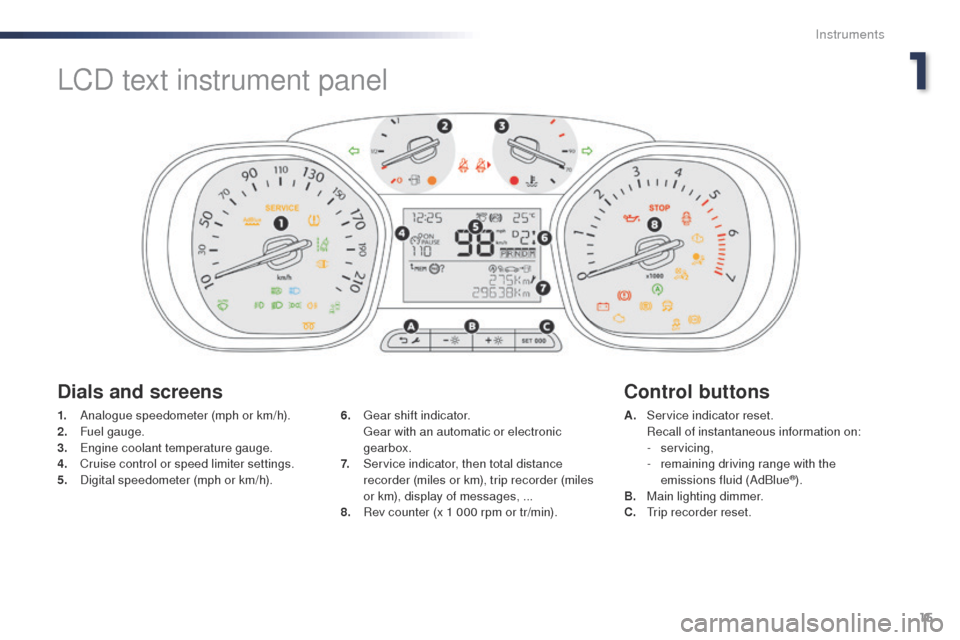
15
Expert_en_Chap01_instruments-de-bord_ed01-2016
1. Analogue speedometer (mph or km/h).
2. Fuel gauge.
3.
E
ngine coolant temperature gauge.
4.
C
ruise control or speed limiter settings.
5.
D
igital speedometer (mph or km/h). A. S
ervice indicator reset. R
ecall of instantaneous information on:
-
servicing,
-
r
emaining driving range with the
emissions fluid (AdBlue
®).
B. M
ain lighting dimmer.
C.
t
r
ip recorder reset.
6.
g
e
ar shift indicator.
g
e
ar with an automatic or electronic
gearbox.
7.
S
ervice indicator, then total distance
recorder (miles or km), trip recorder (miles
or km), display of messages, ...
8.
R
ev counter (x 1 000 rpm or tr/min).
Dials and screens Control buttons
LCD text instrument panel
1
Instruments
Page 18 of 599
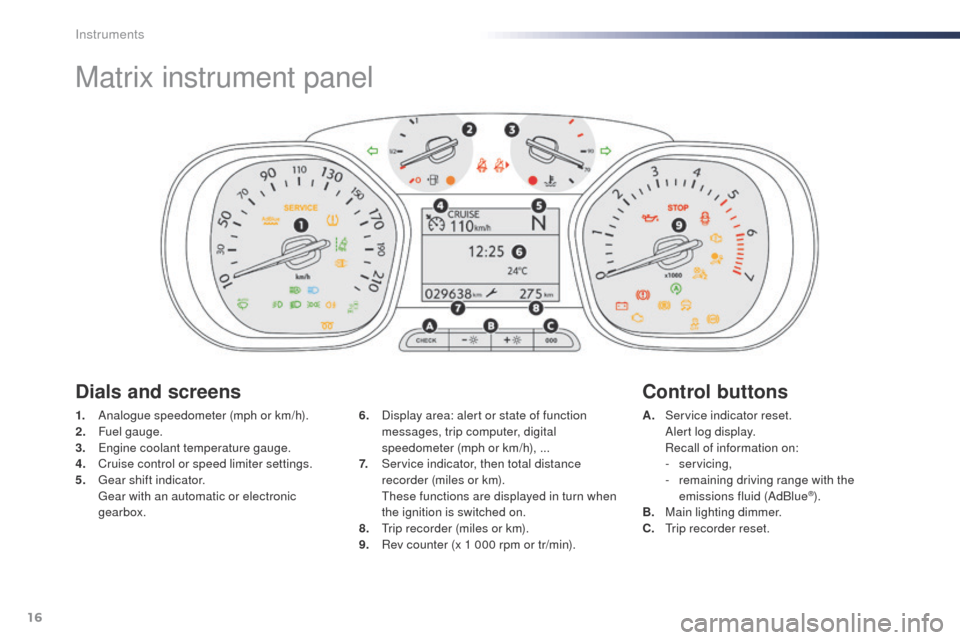
16
Matrix instrument panel
1. Analogue speedometer (mph or km/h).
2. Fuel gauge.
3.
E
ngine coolant temperature gauge.
4.
C
ruise control or speed limiter settings.
5.
g
e
ar shift indicator.
g
e
ar with an automatic or electronic
gearbox. A. S
ervice indicator reset. A
lert log display.
R
ecall of information on:
-
servicing,
-
r
emaining driving range with the
emissions fluid (AdBlue
®).
B. M
ain lighting dimmer.
C.
t
r
ip recorder reset.
6.
D
isplay area: alert or state of function
messages, trip computer, digital
speedometer (mph or km/h), ...
7.
S
ervice indicator, then total distance
recorder (miles or km).
th
ese functions are displayed in turn when
the ignition is switched on.
8.
t
r
ip recorder (miles or km).
9.
R
ev counter (x 1 000 rpm or tr/min).
Dials and screens Control buttons
Instruments
Page 23 of 599
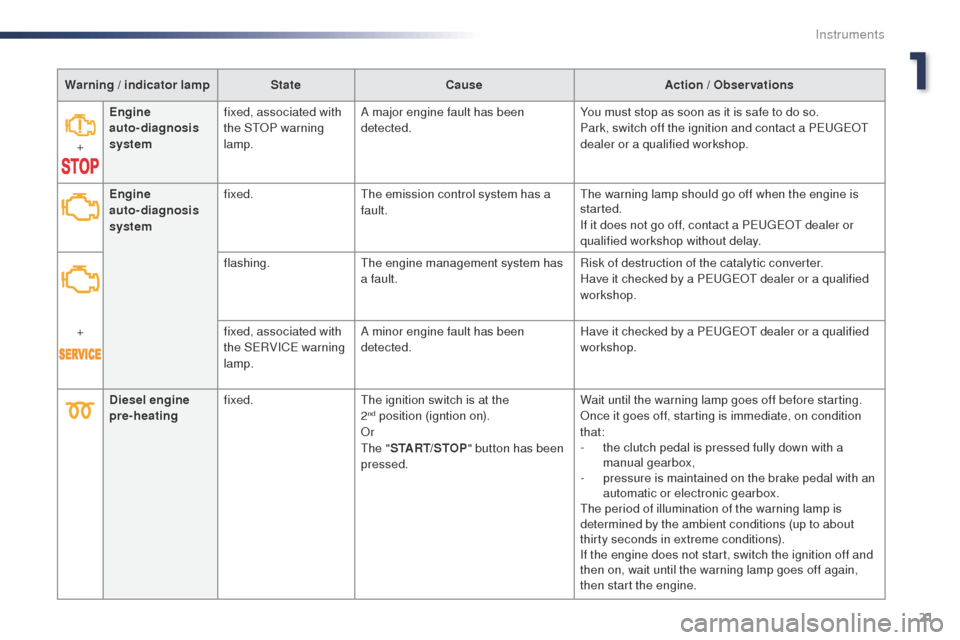
21
Expert_en_Chap01_instruments-de-bord_ed01-2016
Warning / indicator lampStateCause Action / Observations
+ Engine
auto-diagnosis
system
fixed, associated with
the S
t
o
P w
arning
lamp. A major engine fault has been
detected.
You must stop as soon as it is safe to do so.
Park, switch off the ignition and contact a PE
u
g
Eo
t
dealer or a qualified workshop.
Diesel engine
pre-heating fixed.
th
e ignition switch is at the
2
nd position (igntion on).o
r
th
e " START/STOP " button has been
pressed. Wait until the warning lamp goes off before starting.on
ce it goes off, starting is immediate, on condition
that:
-
t
he clutch pedal is pressed fully down with a
manual gearbox,
-
p
ressure is maintained on the brake pedal with an
automatic or electronic gearbox.
th
e period of illumination of the warning lamp is
determined by the ambient conditions (up to about
thirty seconds in extreme conditions).
If the engine does not start, switch the ignition off and
then on, wait until the warning lamp goes off again,
then start the engine.
Engine
auto-diagnosis
system
fixed.
th
e emission control system has a
fault.
th
e warning lamp should go off when the engine is
started.
If it does not go off, contact a PE
u
g
Eo
t dealer or
qualified workshop without delay.
flashing.
the
engine management system has
a fault. Risk of destruction of the catalytic converter.
Have it checked by a PE
u
g
Eo
t dealer or a qualified
workshop.
+ fixed, associated with
the SERVICE warning
lamp.A minor engine fault has been
detected.
Have it checked by a PE
u
g
Eo
t dealer or a qualified
workshop.
1
Instruments
Page 24 of 599
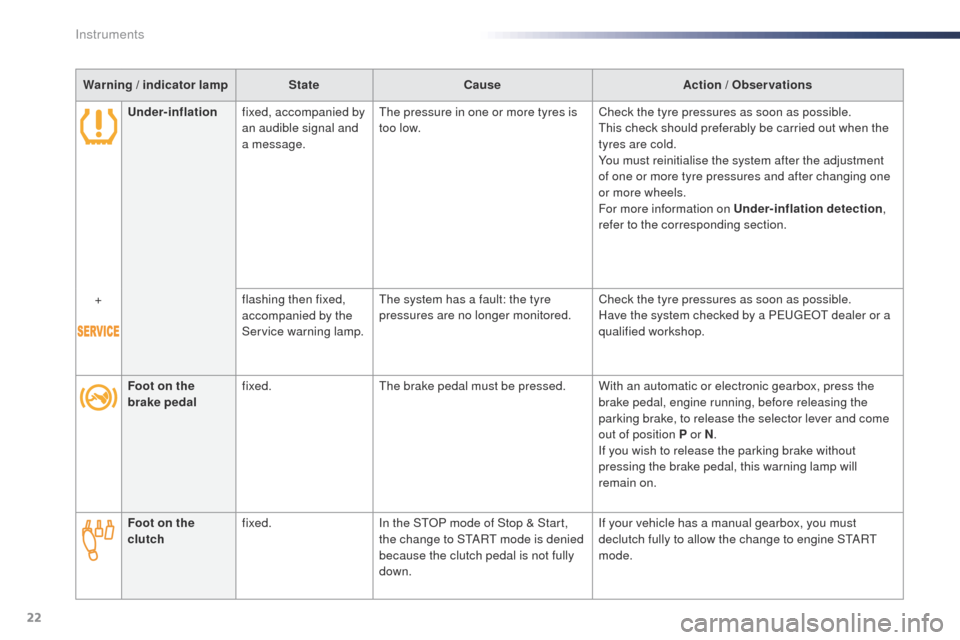
22
Warning / indicator lampStateCause Action / Observations
Under-inflation fixed, accompanied by
an audible signal and
a message.
th
e pressure in one or more tyres is
too low. Check the tyre pressures as soon as possible.
th
is check should preferably be carried out when the
tyres are cold.
You must reinitialise the system after the adjustment
of one or more tyre pressures and after changing one
or more wheels.
For more information on Under-inflation detection ,
refer to the corresponding section.
+ flashing then fixed,
accompanied by the
Service warning lamp.
th
e system has a fault: the tyre
pressures are no longer monitored. Check the tyre pressures as soon as possible.
Have the system checked by a PE
u
g
Eo
t dealer or a
qualified workshop.
Foot on the
brake pedal fixed.
th
e brake pedal must be pressed. With an automatic or electronic gearbox, press the brake pedal, engine running, before releasing the
parking brake, to release the selector lever and come
out of position P or N.
If you wish to release the parking brake without
pressing the brake pedal, this warning lamp will
remain on.
Foot on the
clutch fixed.
In the S
t
o
P m
ode of Stop & Start,
the change to S
tA
R
t
mode is denied
because the clutch pedal is not fully
down. If your vehicle has a manual gearbox, you must
declutch fully to allow the change to engine S
tA
R
t
mode.
Instruments
Page 198 of 599

196
Expert_en_Chap06_conduite_ed01-2016
Driving recommendations
observe the driving regulations and remain
vigilant whatever the traffic conditions.
Pay close attention to the traffic and keep your
hands on the wheel so that you are ready to
react at any time to any eventuality.
on a l
ong journey, a break every two hours is
strongly recommended.
In difficult weather, drive smoothly, anticipate
the need to brake and increase the distance
from other vehicles. Never drive with the parking brake
applied - Risk of overheating and
damage to the braking system!
Risk of fire!
As the exhaust system of your vehicle
is very hot, even several minutes after
switching off the engine, do not park
or run the engine over areas where
inflammable substances and materials
are present: grass, leaves, etc.
Never leave a vehicle unsupervised
with the engine running. If you have
to leave your vehicle with the engine
running, apply the parking brake
and put the gearbox into neutral or
position
N or P, depending on the type
of gearbox.
Driving on flooded roads
We strongly advise against driving on flooded
roads, as this could cause serious damage
to the engine or gearbox, as well as to the
electrical systems of your vehicle.
Important!If you are obliged to drive through water:
-
c
heck that the depth of water does not
exceed 15 cm, taking account of waves
that might be generated by other users,
-
d
eactivate the Stop & Start system,
-
d
rive as slowly as possible without stalling.
In all cases, do not exceed 6 mph
(10 km/h),
-
d
o not stop and do not switch off the
engine.
on l
eaving the flooded road, as soon as
circumstances allow, make several light brake
applications to dry the brake discs and pads.
If in doubt on the state of your vehicle, contact
a PE
u
g
Eo
t dealer or a qualified workshop.
Driving
Page 201 of 599
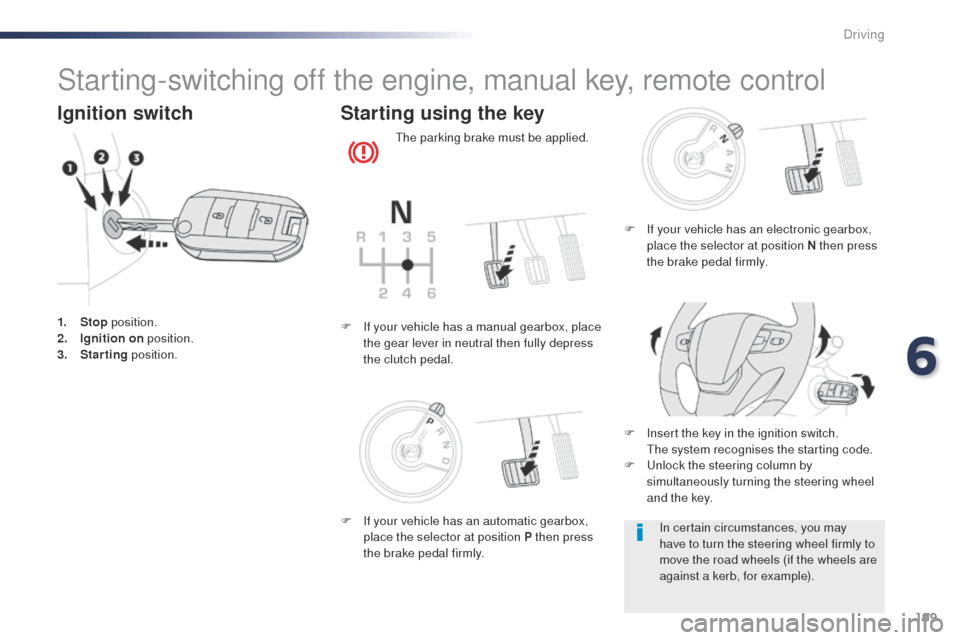
199
Expert_en_Chap06_conduite_ed01-2016
Starting-switching off the engine, manual key, remote control
Ignition switch
1. Stop position.
2. I gnition on position.
3.
S
tarting position.
Starting using the key
the parking brake must be applied.
F
I
nsert the key in the ignition switch.
t
h
e system recognises the starting code.
F
u
n
lock the steering column by
simultaneously turning the steering wheel
and the key.
F
I
f your vehicle has a manual gearbox, place
the gear lever in neutral then fully depress
the clutch pedal.
In certain circumstances, you may
have to turn the steering wheel firmly to
move the road wheels (if the wheels are
against a kerb, for example).
F
I
f your vehicle has an electronic gearbox,
place the selector at position N then press
the brake pedal firmly.
F
I
f your vehicle has an automatic gearbox,
place the selector at position P then press
the brake pedal firmly.
6
Driving